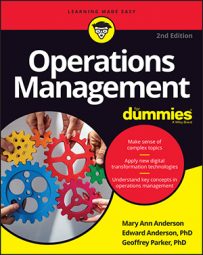Inventory-Management formulas for improving business operations
Managing inventory is an important way for a business to manage variations in demand. Inventory can provide a means to manage demand fluctuation so that process capacity and resource utilization are kept steady and used most efficiently.
Of course, maintaining an inventory isn’t cost-free or risk-free, because inventory represents tied-up cash and storage costs and comes with the risk that the inventory will spoil or become obsolete. In the case of bank or restaurant customers, if they have to wait in a line too long, the risk is a lost customer.
Following, are some formulas for the three most common inventory policies that companies use to try to minimize their risk:
-
Newsvendor inventory policy
-
Continuous review inventory policy
-
Periodic review inventory policy
Newsvendor inventory policy
The newsvendor policy is often also called single period inventory management. As the name implies, the business has one shot to purchase the inventory that it believes it will need to meet customer demand. This policy is typically used for seasonal items, such as swimsuits and snowblowers.
Let μ = expected demand, σ = standard deviation of demand, Q = an order quantity, ES = expected sales, ELS = expected lost sales, ELI = expected leftover inventory,
Newsvendor optimal order quantity is Q such that:

Continuous review inventory policy
In a continuous review inventory policy, you continually monitor your inventory and order a fixed quantity every time your inventory level reaches a preset quantity. The fixed quantity is often called the economic order quantity (EOQ) because it’s the quantity that minimizes your total inventory costs. You place an order for the EOQ whenever your inventory level reaches the set reorder point (ROP). To calculate the EOQ and ROP, use the following equations.
Let D = annual demand for the product, S = setup cost to place one order, H = holding cost to keep one item in inventory for a year, SS = safety stock, and z = the z value for the desired service level.

ROP = (Average Demand * Average Delivery Lead Time) + Safety Stock
Periodic review inventory policy
In some cases, it’s impractical to continuously monitor inventory levels, and a business may choose to periodically monitor. In this policy, the firm sets a certain time (T) to check inventory levels. At this time, the company orders inventory to bring levels up to a target inventory (TI). The company typically sets the T based on its operations and calculates the TI based on this T using the following equation:
TI = Average Demand * (Average Lead Time + T) + SS
Where SS is calculated as:
Business operations: formulas for project management
The management of one-time projects to install new operations or change existing operations is a major discipline for operations managers. Though based on similar skills used in optimizing ongoing operations, project management focuses on the completion of a discrete project on time, on budget, and in scope, as planned and approved.
Project managers use the following formulas to estimate the shortest and most likely project completion time, along with expected variation, expected cost, and variation.
CPM (critical path method)
Let ES = earliest start time, EF = earliest finish time, LS = latest start time, and LF = latest finish time for an activity.
Slackactivity = LF – EF = LS – ES
PERT (program evaluation and review technique)
Let a = the optimistic, m = the most likely, and b = the pessimistic estimates for the duration of an activity.
For PERT, the expected duration of an activity and its variance are:
This formula also works for estimating individual activity costs.


